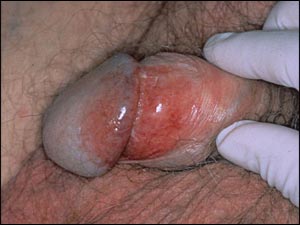Zoon’s Balanitis, also called Balanitis Plasmacellularis, is not malignant or pre-malignant but mimics the clinical appearance of Erythroplasia of Queyrat, which is Squamous Cell Cancer in situ of the glans penis. I occasionally encounter Zoon’s Balanitis in my The Woodlands dermatology and Conroe dermatology offices. Zoon’s Balanitis begins with plasma cell inflammation in the glans penis, which clinically appears as a moist red patch on the glans penis. Zoon’s Balanitis is most common in uncircumcised men and usually doesn’t begin until the mid 20’s but can occur at almost any age later in life. There is a female counterpart to Zoon’s Balanitis called Vulvitis Plasmacellularis. Additionally, there is a facial counterpart to Zoon’s Balanitis called Plasmacytosis Cirumorificialis that is found on the oral mucosa, cheeks, lips and tongue. Both Vulvitis Plasmacellularis and Plasmacytosis Circumorificialis are benign but clinically mimic Squamous Cell Cancer. Treatment involves topical steroids and anti-candidal medicines can be helpful. Circumcision is usually curative for Zoon’s Balanitis.





